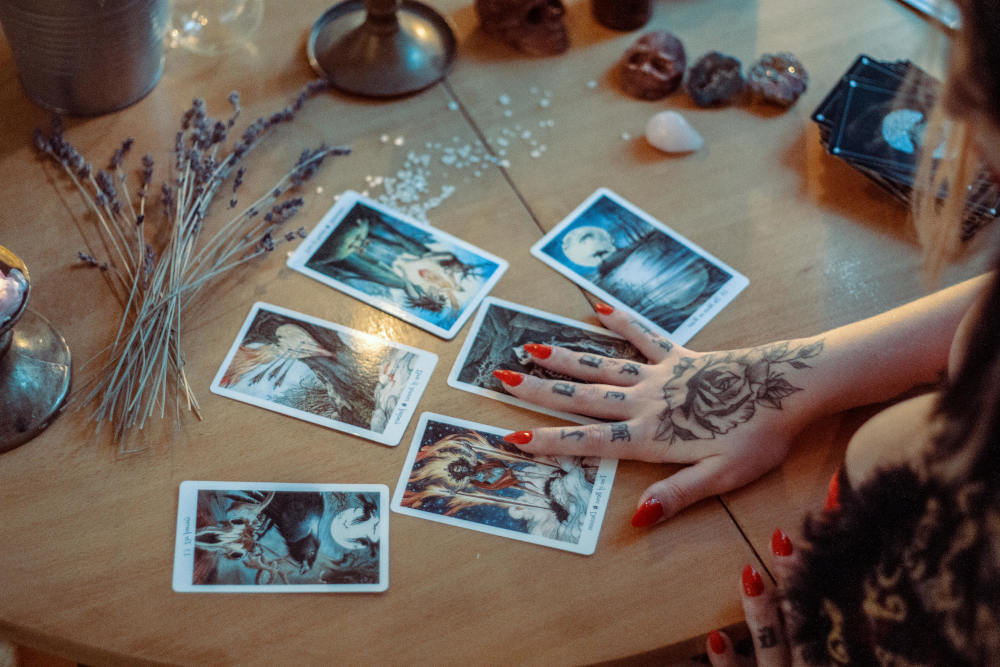
In the world of divination and spiritual guidance, angel cards and tarot cards are often used interchangeably by beginners. At first glance, both involve drawing cards and interpreting meanings—but beneath the surface, they differ in structure, origin, spiritual focus, and how they’re used.
So, are angel cards and tarot cards the same? No—but they share some common goals. While both tools aim to offer insight, clarity, and connection to higher wisdom, the way they deliver messages and their intended focus differ significantly.
This article explores everything you need to know to understand how angel cards and tarot cards compare—and which may be right for you.
Panaprium is independent and reader supported. If you buy something through our link, we may earn a commission. If you can, please support us on a monthly basis. It takes less than a minute to set up, and you will be making a big impact every single month. Thank you!
Understanding Tarot Cards
Origins and History
Tarot cards have a deep, complex history dating back to 15th-century Europe, where they originated as playing cards. It wasn’t until the 18th century that they began to be used for esoteric and spiritual purposes. The structure we know today—78 cards divided into Major and Minor Arcana—was solidified during this transformation.
Tarot’s historical connections include astrology, numerology, alchemy, and Kabbalah, which all contribute to the symbolic depth of each card.
Structure
A standard tarot deck contains 78 cards:
-
Major Arcana (22 cards): Represents powerful life themes and spiritual lessons (e.g., The Fool, The Tower, The World).
-
Minor Arcana (56 cards): Divided into four suits (Cups, Swords, Wands, and Pentacles), each containing 14 cards. These reflect everyday experiences and personal dynamics.
Each tarot card has specific traditional meanings, both upright and reversed, and is often used in spreads—specific layouts that guide interpretation based on card position.
Purpose and Use
Tarot is known for its structured, introspective style. Readers use it to explore:
-
Life challenges
-
Personal growth
-
Relationship dynamics
-
Career paths
-
Spiritual evolution
Because of its depth, tarot is often used for self-reflection and shadow work—uncovering hidden patterns and addressing subconscious blocks.
Understanding Angel Cards
Origins and Development
Angel cards are a much more recent development, becoming popular in the late 20th century. They were pioneered by spiritual authors and intuitive healers—most notably Doreen Virtue, who helped popularize angel card reading through her decks and workshops.
Angel cards stem from the New Age movement and are rooted in the belief that angels, archangels, or divine beings can communicate guidance through intuitive tools.
Structure
Unlike tarot, angel cards have no set number of cards or standardized system. Decks vary widely in size, art style, and message. Some decks feature 44 cards, others more or less. Each card typically includes:
-
The name of an angel or spiritual being
-
A comforting or inspiring message
-
A brief explanation or affirmation
There are no suits, arcana, or traditional layouts—though some readers develop their own routines.
Purpose and Use
Angel cards are focused on gentle, loving guidance from the spiritual realm. Common themes include:
-
Divine timing
-
Reassurance during difficult times
-
Encouragement and self-worth
-
Messages from guardian angels
They are often used during meditation, prayer, or energy healing sessions, and many users describe the experience as nurturing and uplifting.
Key Differences Between Angel and Tarot Cards
| Aspect | Tarot Cards | Angel Cards |
|---|---|---|
| Origin | 15th-century Europe | 20th-century New Age movement |
| Structure | Fixed 78-card system | No fixed number; varies by deck |
| Symbolism | Archetypes, suits, astrology, numerology | Angels, divine beings, spiritual affirmations |
| Tone | Can be light or intense, includes challenges | Always positive and gentle |
| Complexity | High—requires study of symbols and meanings | Low—accessible and intuitive |
| Main Use | Insight into life events, inner growth, spiritual lessons | Encouragement, comfort, spiritual connection |
| Spiritual Focus | Inner wisdom, subconscious, archetypal energies | Messages from angels or higher beings |
Are Angel Cards Easier to Use?
In general, yes. Angel cards are designed to be simple, comforting, and easy to interpret. Most come with a guidebook that explains each card’s meaning. They don't require memorization or study, which makes them ideal for:
-
Beginners
-
Sensitive individuals
-
People seeking daily affirmation or emotional support
Tarot, on the other hand, involves a learning curve. Readers need to become familiar with:
-
78 unique cards
-
Upright and reversed meanings
-
Symbolic imagery
-
Spread positions and relationships
This makes tarot more layered and potentially more revealing, but also more intimidating for those just starting out.
Do They Offer the Same Kind of Guidance?
Not exactly. While both aim to offer insight, the tone and depth of the guidance differ.
Tarot: Reflective and Transformational
Tarot dives deep. It can reveal truths you may not want to face, highlight patterns you need to break, or illuminate paths that require courage. It doesn’t sugarcoat, but it empowers you to understand yourself and take conscious action.
Tarot is excellent for:
-
Understanding complex situations
-
Making difficult decisions
-
Addressing inner conflicts
-
Shadow work and self-transformation
Angel Cards: Uplifting and Reassuring
Angel cards offer reassurance that you are loved, protected, and guided. They often remind you to trust, surrender, and remain positive, even when life feels uncertain.
Angel cards are ideal for:
-
Daily inspiration
-
Spiritual comfort
-
Emotional healing
-
Connecting with divine or angelic presence
Can You Use Angel and Tarot Cards Together?
Absolutely. Many spiritual practitioners and readers combine both decks to create a more holistic and balanced reading.
A Common Approach:
-
Start with a tarot reading to gain structured insight into your situation.
-
Follow up with an angel card to receive supportive messages or encouragement from a higher source.
This pairing helps blend the mental clarity of tarot with the spiritual comfort of angel cards.
Spiritual Beliefs Behind Each Deck
Tarot and the Subconscious Mind
Tarot is often seen as a tool that taps into the subconscious or universal consciousness. It reflects inner truths through archetypes, much like Carl Jung’s theories on the collective unconscious.
Angel Cards and Divine Guidance
Angel cards are rooted in the belief that there are real spiritual beings—angels, archangels, spirit guides—watching over us. The messages in these cards are said to come from these higher beings, channeled through the reader’s intuition.
While tarot can be secular or spiritual depending on the user, angel cards are almost always deeply spiritual or religious in nature.
Common Misconceptions
1. Angel Cards Are Just Tarot with a Nicer Name
False. While both are card-based systems, they differ dramatically in structure, tone, and purpose. Angel cards are a form of oracle card, and lack tarot’s symbolic framework.
2. Tarot Cards Are Scary or Evil
Many people fear tarot due to associations with the occult or dark symbolism. In truth, tarot is neither evil nor predictive of doom. It simply mirrors your internal state and spiritual path. Any fear often stems from misunderstanding or pop culture myths.
3. Angel Cards Are Less Powerful
Some argue that angel cards are less meaningful because they are more “feel-good.” However, emotional and spiritual healing is just as important as insight. Angel cards may lack complexity, but they offer real value for those needing light, faith, or encouragement.
Which Deck Should You Choose?
Here are a few questions to help you decide:
-
Do you enjoy structure, symbolism, and deep insight? → Start with Tarot.
-
Do you want daily inspiration or quick guidance? → Try Angel Cards.
-
Are you drawn to spiritual beings or divine communication? → Angel Cards may resonate more.
-
Do you want to develop intuitive skills and explore archetypes? → Tarot offers a rich foundation.
Ultimately, your intuition should guide your choice. If a deck resonates with you—whether tarot or angel—it’s the right one for your journey.
Final Thoughts
Angel cards and tarot cards are both powerful spiritual tools, but they are not the same. Tarot offers a structured system rich in symbolism and transformation. Angel cards provide gentle, divine encouragement focused on love and light.
One isn’t better than the other—they serve different purposes. Some seekers prefer tarot’s depth, while others turn to angel cards for emotional healing. Many use both, depending on the situation or question at hand.
Whichever path you choose, both cards share a central truth: you are not alone. Whether guided by inner wisdom or angelic messages, these cards help you hear the voice within and walk your path with greater trust, insight, and clarity.
Was this article helpful to you? Please tell us what you liked or didn't like in the comments below.
About the Author: Alex Assoune
What We're Up Against
Multinational corporations overproducing cheap products in the poorest countries.
Huge factories with sweatshop-like conditions underpaying workers.
Media conglomerates promoting unethical, unsustainable products.
Bad actors encouraging overconsumption through oblivious behavior.
- - - -
Thankfully, we've got our supporters, including you.
Panaprium is funded by readers like you who want to join us in our mission to make the world entirely sustainable.
If you can, please support us on a monthly basis. It takes less than a minute to set up, and you will be making a big impact every single month. Thank you.































0 comments